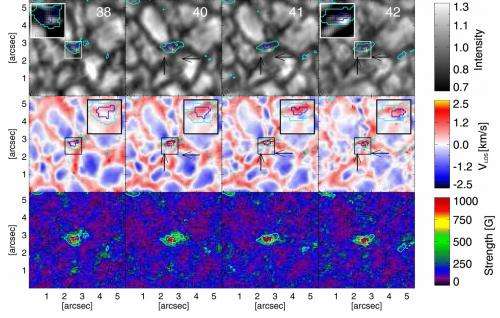Spanish instrument reveals how magnetic structures in the Sun are born and evolve

The IMaX magnetograph, an instrument entirely developed in Spain, has revealed how flux tubes are formed and evolve in the Sun. These tubes are considered to be the building blocks of solar magnetism but their existence had only heretofore been demonstrated indirectly due to their small size. The incomparably high resolution yielded by the SUNRISE mission has for the first time made it possible to follow one of them, and it turned out to be different from what had been suggested until now.
IMaX was designed to overcome one of the major challenges facing astrophysics today, the solar magnetic field, which manifests itself in many different forms, such as the eleven year cycle, sunspots or solar storms. Today, it is considered the key to a deeper understanding of the Sun, to predicting its behaviour and to assessing to what extent it will affect us. Magnetic flux tubes, with a size of a few hundred kilometres, are essential to the picture because large structures such as sunspots are made up of smaller elements.
Seen at a scale of one thousand kilometres, the surface of the Sun seems to be governed by granulation, a convective phenomenon similar to the bubbling of boiling water: low density hot gas rises to the surface; as it cools off, its density increases and the gas descends again.
"Among the granules we find weak magnetic field concentrations," says Iker S. Requerey, researcher at the Institute of Astrophysics of Andalusia (IAA-CSIC) and first author of the study. The granules converge around a centre towards which they drag the small fields, which then agglomerate and intensify, giving rise to a magnetic flux tube."

In this first phase, reckoned in theory but observed for the first time in the course of this study, the tube displays low magnetic energy. However, since the magnetic field inhibits convection, the gas inside the tube cools off and descends, which causes the tube to contract and increase the intensity of the magnetic field.
"It seemed like the development of the tubes ended there, but we have discovered that they are unstable structures," says Jose Carlos del Toro Iniesta, supervisor of Requerey's PhD thesis. The twenty-three minute time series obtained by IMaX/Sunrise shows that the tube displays an oscillatory behaviour, gaining and losing intensity with time. "Not only have we been able to observe that sequence for the first time, but we have also found an ulterior, unknown phase which deserves to be studied," Del Toro concludes.
More information: I. S. Requerey "The history of a quiet-Sun magnetic element revealed by IMAX/SUNRISE". Astronomy & Astrophysics. DOI: stacks.iop.org/0004-637X/789/6
Journal information: Astronomy & Astrophysics
Provided by Instituto de Astrofísica de Andalucía












.jpeg)







